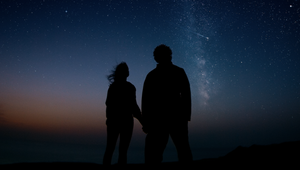
Odin’s Blessing: How Volumetric Capture Recreated a Realistic VR Viking Battle

You’re seated at the rear of a sturdy longboat, your most trusted friends and family surrounding you as the oars glide silkily through the water of the Norwegian fjord you’re navigating. The rowers are keeping it steady, trying to make sure they maintain the element of surprise. You’re part of a moonlit raid, your band of fellow warriors armed with axe and bow, primed for the action ahead. You pass small camps and settlements on the banks, torches flickering in the distance. If you didn’t suspect what might be coming you might mistake the atmosphere for tranquility.
This is the setting that ‘Virtual Viking - The Ambush’ puts you in. Opening last Friday as the centrepiece of The Viking Planet in Oslo, the VR experience immerses you in the world of 840AD like nothing that’s ever been achieved. After a year-long endeavour building it, visitors to the new historical entertainment attraction in the heart of the Norwegian capital can finally experience life in a longboat.
The Ridley Scott Creative Group’s RSA Films and The Viking Planet partnered with immersive media company Hammerhead to create the experience, making use of its ground-breaking volumetric capture technology. It’s the world’s first virtual reality battle scene using the tech.

Steve Jelley, founder and managing director of Hammerhead, recalls the challenge that faced The Viking Planet over a year ago: “How do we make something that really delivers on the epic Viking experience that everyone's expecting?” In terms of storytelling, it had to be a thrill. “Think about it. A historical epic,” he says. “Who are you going to call? Ridley Scott!”
Soon RSA Films director Erik Gustavson was on board to handle the narrative task. “He knows how to get a fantastic performance,” says Steve. “RSA know how to put on a large scale production, cast it, direct everybody.”

The 11-minute experience tells the story of a Viking raid in the ninth century. It begins, in the tradition of the Norse sagas, around a campfire as an old man tells the story from his youth. Soon you are plunged into a longboat in his flashback sequence and the action begins.
While VR experiences can often be isolated, solo experiences, this isn’t the case at The Viking Planet, where viewers will be sitting in a reconstructed wooden longboat in a group of 40, all experiencing the same narrative, told on the latest VR headsets from HP. They have twice the resolution of Oculus, says Steve.
Hammerhead built the experience in Unreal Engine and to make sure it was as realistic as 2019 technology can achieve, they used volumetric capture. This meant they could put real actors’ movements in the VR experience, rather than animating the characters like a game would. Dimension, the studio that Hammerhead owns, was the first volumetric capture studio to open, with Microsoft’s Mixed Reality Capture technology. It’s dedicated to capturing and digitising realistic human performances. There are only two in the world, the other being in LA.

Over 30 actors were filmed in the Dimension studio using 106 cameras - 53 conventional cameras and 53 infra-red cameras. This process generated 10GB of data per second to create an accurate digital mesh of the actors moving in the space, replicating the details of every movement and fold in their historically accurate clothing. “The infra-red cameras see form better than they see colour and the algorithms we have from Microsoft put them together,” explains Steve.
“Pretty much all of the process has never been done before. Nobody’s ever put this many volumetric captures in a scene, nobody’s tried to create this level of realism around people. Why are we the first? Because we’re the only people to try.”

Every detail was spot on. Working with the Museum of Cultural History, Experience Avaldsnes, and the author and Viking historian Kim Hjardar, the RSA production team ensured that all the props, weapons and boats were exactly as ninth-century Norsemen would know them.
Additionally, Norway’s west coast was recreated using photogrammetry to create a historically accurate setting for the experience. “There was a lot of discussion about how high the mountains are,” says Steve. The dialogue is even delivered in accurate Old Norse.
The client was “very specific about making sure it’s historically accurate, making sure the fjords are realistic, that the vegetation is correct, costumes, weapons, helmets… all of that,” says Steve. They worked on many versions of the boat to make sure they got it right.

In terms of acting talent, Ross O’Hennessy, Murray McArthur and Wolfie Hughes from Game of Thrones were brought in to take part. Wolfie acted as battle coordinator for the series and advised on some of the other scenes.
The result is compelling. And Steve’s convinced the realism volumetric capture provides means that this sort of entertainment is going to take off in the next few years. “There are a lot of hype cycles around VR,” he says, “but fundamentally it’s an immersive medium and we’re now at the point where people will pay for tickets to go and see it. VR has gone from being a games console thing to that. It’s a new category of entertainment.”
















